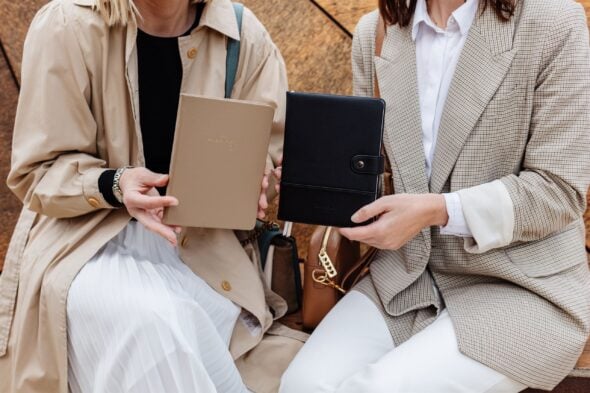The following is adapted from Secret Pandemic by Simone Heng.
My father worked in a news agency seven days a week for almost twenty years, and I loved watching my father serve his customers. During school holidays, I would be sent to shadow my dad in the shop. My mother thought if I learned to count back change manually, I would become better at math in school. What she didn’t count on was the fact my dad was deeply compassionate.
His news agency was opposite a nursing home. I would watch older adults on scooters zip over to buy scratch tickets. These people had the most incredible stories, many of them migrants or even orphans brought to western Australia to work when they were young.
It was my father’s incredible knack for building rapport almost instantly that primed his customers, making them feel safe to engage in self-disclosure and vulnerability. In his book The Art of Reading Minds, author Henrik Fexeus says the basic rule of rapport is to “adapt to how the other person communicates” versus imposing what you want to talk about and how you want to talk about it.
Good rapport is magic because it allows people to feel closer to us and eventually be more easily persuaded by our agenda because they like us. This may sound a tad inauthentic but let me assure you, in a world that has been socially distanced, a world increasingly polarized, these innate steps of connection need to be signposted to bring us back together.
My father taught me many lessons about how to build rapport. Below are some of the most valuable ones I’ve carried with me throughout my life.
Harness the Power of Your Voice
If a new Malaysian migrant customer came in, my father would lean deep into his hips, giving off a casual air, and thicken his Asian accent. The switch almost said, “I know I have been in Australia over a decade, I know I have raised my family here, but I am still like you, my Asian brother.” Then the two would all-out debate which country had the best laksa, Singapore or Malaysia.
Then, like a switch, as decisive as traffic lights turn from red to green, if a European customer came in, a German migrant who had been in Australia for two decades, my father would neutralize his accent, mirror the man’s upright posture, and talk about the Eurovision song contest. God, we loved Eurovision!
My father neutralizing his accent was not an attempt to put on airs or to negate his Asian-ness. Rather it was a simple attempt to be understood more quickly through clarity of communication and this expedited connection. In so doing, he made it far less work for his customers to connect with him.
The person you’re speaking with might be a quiet talker. Match their volume level. If they speak a language you speak as well, switch to theirs. If they speak English as a second language and struggle to understand, slow your own speech down. Make it easier for the other person on any level to connect with you more quickly, meeting them more than halfway.
Meet People Where They Are
I would listen intently to what my father would say to his customers, who would profoundly vary in age and background. He would honor them by always talking about the things they wanted to talk about.
For example, when a British customer came in, my father would talk at length about the English Premier League and break down the match play by play. I often wondered why he would allow me to stay up later in the Aussie winter and crack chestnuts in bed watching these matches. My father was a golf fan himself; it’s what he played, so it was strange to me to make this effort to watch football also. He was doing it to make sure he always had content to connect with his customers because he knew those customers kept the chestnuts in my hands, the rice bowl in my stomach, and the private school uniform on my back.
Try putting aside your needs to discuss what you want to talk about in initial meetings with a new connection. Just listen, soak up who the person is first, and then connect with them on the topics they prefer where you have some common ground. Eventually, when trust and rapport are established, they should come and ask you more about your likes and loves too.
Be on the Lookout for Things to Connect on
I often get asked how to connect with a new person in this way if they don’t disclose anything about themselves. Great human connectors know that connection leaves clues, so they scan for commonalities constantly.
I would often see my dad glance at a customer’s attire and see them wearing a cap emblazoned with their favorite sports team’s logo. He would then rattle off any trivia he knew about this team or the sport they played to begin the conversation.
Prime yourself to look for connection points when you are at your next social gathering or virtual meeting. What clues can you see that you could connect on?
Use Your Body to Connect
My father would mirror the body posture of his customers over the counter. This tells the brain of the person you are trying to connect with that “this person is like me.” My dad did a great deal of communicating with his body despite being cordoned off by his shop counter.
Just like what we experience during virtual conferences today, he only had his upper body to communicate with. Mirroring is also valuable for digital communication; frame the bottom of your laptop screen when on a virtual conference to where your sternum ends.
By having your hands in the shot, you build trust with your audience. As humans, we are suspicious of concealed hands. This goes back to our days as early humans, where our brains became wired to immediately check that a stranger was not holding a weapon in their hands that could hurt us. To build trust and connection, frame your virtual screen wider to include your arms and your upper torso.
Make Others Feel Heard
Over the years, regular customers came to trust my father deeply because of his consistent choice to be of service in his communication. He would, in a sense, inconvenience himself, his need to talk about whatever he wanted to talk about, in the language or accent of his preference, to make others feel served. To make others feel welcomed and have their stories validated.
I learned quickly that true connection happens when others feel seen and heard. These small tweaks in communication allowed my dad’s customers to perceive him as one of them, a member of their tribe.
Once rapport was established, he built trust by consistently showing up in this way over the course of decades. The rapport my father built created a deep trust, which allowed long-term connection to happen.
For more on the art of building rapport, you can find Secret Pandemic on Amazon.
About the Author
 Simone Heng is a human connection specialist and former international broadcaster for Virgin Radio Dubai, HBO Asia, and CNBC, among others. With over fifteen years of experience around the world as a communicator on-air, on stage, and one-on-one, connection has always been her life’s work. As a speaker, Simone inspires people to connect in a world thirsty for connection. She has spoken to thousands and often for Fortune 500 organizations. Her clients include Google, Bytedance, Salesforce, SAP, L’Oréal, TEDx, The United Nations, and many more. Simone and her work have been featured on CNN and in Vogue, Elle, and Harper’s Bazaar, among others.
Simone Heng is a human connection specialist and former international broadcaster for Virgin Radio Dubai, HBO Asia, and CNBC, among others. With over fifteen years of experience around the world as a communicator on-air, on stage, and one-on-one, connection has always been her life’s work. As a speaker, Simone inspires people to connect in a world thirsty for connection. She has spoken to thousands and often for Fortune 500 organizations. Her clients include Google, Bytedance, Salesforce, SAP, L’Oréal, TEDx, The United Nations, and many more. Simone and her work have been featured on CNN and in Vogue, Elle, and Harper’s Bazaar, among others.



